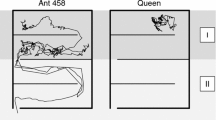Abstract
In order to shed light on the collective behavior of social insects, we analyzed the behavior of ants from single to multi-body. In an experimental set-up, ants are placed in hemisphere without a nest and food. Trajectory of ants is recorded. From this bottom-up approach, we found that collective behavior of ants as follows: 1. Activity of single ant increases and decreases periodically. 2. Spontaneous meeting process is observed between two ants and meeting spot of two ants is localized in hemisphere. 3. Result on division of labor is obtained between two ants.
Similar content being viewed by others
Explore related subjects
Discover the latest articles, news and stories from top researchers in related subjects.References
Hölldobler B, Wilson EO (1990) The ants. Harvard University Press
Hölldobler B, Wilson EO (1995) Journey to the ants: a story of scientific exploration, Harvard University Press
Gordon D (2000) Ants at work. W W Norton & Co Inc.
Bonabeau E, Theraulaz G, Dorigo M (1999) Swarm intelligence: from natural to artificial systems, Oxford University Press
Krieger MJB, Billeter JB, Keller L (2000) Ant-like task allocation and recruitment in cooperative robots. Nature 406:992–995
Balch T, Parker LE (1992) Robot teams: from diversity to polymorphism, A K Peters
ColeShort-term activity cycles in ants. Behav Ecol Sociobiol 31:181–187
Cole BJ, Cheshire D (1996) Mobile cellular automata models of ant behavior. Am Naturalist 148:1–15
Uchikawa T, Sugawara K, Kikuchi T, Tsuji K, Hayakawa Y (2007) Time-series analysis of ant behavior and its modeling (in Japanese). IEICE Tech. Report. Nonlinear problems 106(573):27–30
Author information
Authors and Affiliations
Corresponding author
Additional information
This work was presented in part at the 13th International Symposium on Artificial Life and Robotics, Oita, Japan, January 31–February 2, 2008
About this article
Cite this article
Hayashi, Y., Yuki, M., Sugawara, K. et al. Analysis and modeling of ants’ behavior from single to multi-body. Artif Life Robotics 13, 120–123 (2008). https://doi.org/10.1007/s10015-008-0571-z
Received:
Accepted:
Published:
Issue Date:
DOI: https://doi.org/10.1007/s10015-008-0571-z




